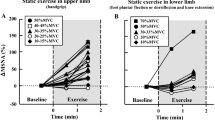Summary
To clarify whether sympathetic nerve activity increases in relation to the tension of a sustained muscle contraction, muscle sympathetic nerve activity (MSA) was recorded directly from the peroneal nerve fascicle at the popliteal fossa by means of tungsten microelectrodes in five healthy male subjects. A sustained muscle contraction was performed by handgrip for two minutes in a supine position at tensions of 10, 30 and 45% of maximal grip strength (MGS). MSA, electrocardiogram (ECG) using bipolar electrodes from the chest and surface electromyogram (EMG) from the extensor pollicis longus were recorded simultaneously before and during the sustained handgrip. Arterial blood pressure was measured at the resting upper arm by auscultation. During handgrip with tensions of 10, 30 and 45% MGS, average MSA burst rate (bursts · min−1) increased to 122, 152 and 230% of the resting value, respectively. During the same experimental procedures with tensions of 10, 30 and 45% MGS, average heart rate increased to 105, 110 and 111% of the resting value. These results confirm that sympathetic outflow to a resting muscle is increased with elevation of tension in an active muscle. This process would promote perfusion pressure in the active muscle.
Similar content being viewed by others
References
Barcroft H, Greenwood B, Whelan RF (1963) Blood flow and venous oxygen saturation during sustained contraction of the forearm muscles. J Physiol 168:848–856
Bevegård BS, Shepherd JT (1966) Reaction in man of resistance and capacity vessels in forearm and hand to leg exercise. J Appl Physiol 21:123–132
Blair DA, Glover WE, Roddie IC (1961) Vasomotor responses in the human arm during leg exercise. Circ Res 9:264–274
Blomqvist CG, Lewis SF, Taylor WF, Graham RM (1981) Similarity of the hemodynamic responses to static and dynamic exercise of small muscle groups. Circ Res [Suppl I] 48:87–92
Blumberg H, JÄnig W, Rieckmann C, Szulczyk P (1980) Baroreceptor and chemoreceptor reflexes in postganglionic neurons supplying skeletal muscle and hairy skin. J Auto Nerv Sys 2:22–240
Bonde-Petersen F, Mark AL, Nielsen E (1975) Local muscle blood flow and sustained contractions of human arm and back muscles. Eur J Appl Physiol 34:43–50
Christensen NJ, Gallbo H (1983) Sympathetic nervous activity during exercise. Ann Rev Physiol 45:139–153
Delius W, Hagbarth K-E, Hongell A, Wallin BG (1972) Manoeuvres affecting sympathetic outflow in human muscle nerves. Acta Physiol Scand 84:82–94
Gallbo H (1983) Hormonal and metabolic adaptation to exercise. Thieme-Stratton, Stuttgart
Goodwin GM, McCloskey DI, Mitchell JH (1972) Cardiovascular and respiratory responses to changes in central command during isometric exercise at constant muscle tension. J Physiol 226:173–190
Gregor M, JÄnig W (1977) Effects of systemic hypoxia and hypercapnia on cutaneous and muscle vasoconstrictor neurons to the cat's hind limb. Pflügers Arch 368:71–81
Humphreys PW, Lind AR (1963) The blood flow through active and inactive muscles of the forearm during sustained hand-grip contractions. J Physiol 166:120–135
Iwase S, Mano T, Nakamura M (1984) Effects of head-up/down tiltings on muscle sympathetic activities in man. Environ Med 28:27–36
Kaufman MP, Longhurst JC, Rybicki KJ, Wallach JH, Mitchell JH (1983) Effects of static muscular contraction on impulse activity of groups and afferents in cats. J Appl Physiol 55:105–112
Lind AR, Dahms TE, Williams CA, Petrofsky JS (1981) The blood flow through the “resting” arm during hand-grip contractions. Circ Res [Suppl I] 48:104–109
Longhurst J, Zelis R (1979) Cardiovascular responses to local hind limb hypoxemia: relation to the exercise reflex. Am J Physiol 237:H359-H365
Mitchell JH, Kaufman MP, Iwamoto GA (1983) The exercise pressor reflex: its cardiovascular effects, afferent mechanisms, and central pathways. Ann Rev Physiol 45:229–242
Mark AL, Victor RG, Nerhed C, Wallin BG (1985) Microneurographic studies of the mechanisms of sympathetic nerve response to static exercise in human. Circ Res 57:461–469
Richardson D (1981) Blood flow responses of human calf muscles to static contractions at various percentages of MVC. J Appl Physiol 51:929–933
Rusch NJ, Shepherd JT, Webb RC, Vanhoutte PM (1981) Different behavior of the resistance vessels of human calf and forearm during contralateral isometric exercise, mental stress, and abnormal respiratory movements. Circ Res [Suppl I] 48:118–130
Sato A, Schmidt RF (1973) Somatosympathetic reflexes: Afferent fibers, central pathways, discharge characteristics. Physiol Rev 53:916–947
Schibye B, Mitchell JH, Payne FC, Saltin B (1981) Blood pressure and heart rate response to static exercise in relation to electromyographic activity and force development. Acta Physiol Scand 113:61–66
Sevedenhag J, Wallin BG, Sundlöf G, Henriksson J (1984) Skeletal muscle sympathetic activity at rest in trained and untrained subjects. Acta Physiol Scand 120:499–504
Shepherd JT, Blomqvist CG, Lind AD, Mitchell JH, Saltin B (1981) Static (isometric) exercise, retrospection and introspection. Circ Res [Suppl I] 48:179–188
Sundlöf G, Wallin BG (1977) The variability of muscle nerve sympathetic activity in resting recumbent man. J Physiol 272:383–397
Sundlöf G, Wallin BG (1978) Human muscle nerve sympathetic activity at rest. Relationship to blood pressure and age. J Physiol 274:621–637
Vallbo åB, Hagbarth K-E, Torebjork HE, Wallin BG (1979) Somatosensory, proprioceptive, and sympathetic activity in human peripheral nerves. Physiol Rev 49:919–957
Watson RDS, Littler WA, Eriksson B-M (1980) Changes in plasma noradrenaline and adrenaline during isometric exercise. Clin Exp Pharmacol Physiol 7:399–402
Yasuda Y, Miyamura M (1985) Cross transfer effects of muscular training on blood flow in the ipsilateral and contralateral forearm. Eur J Appl Physiol 51:321–329
Author information
Authors and Affiliations
Rights and permissions
About this article
Cite this article
Saito, M., Mano, T., Abe, H. et al. Responses in muscle sympathetic nerve activity to sustained hand-grips of different tensions in humans. Europ. J. Appl. Physiol. 55, 493–498 (1986). https://doi.org/10.1007/BF00421643
Accepted:
Issue Date:
DOI: https://doi.org/10.1007/BF00421643




